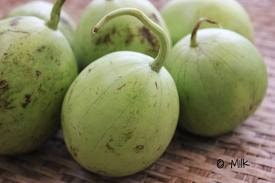Cantaloupe cures jaundice and cirrhosis
Cantaloupe is a type of squash plant. According to oriental medicine, it has a sweet taste and cold properties, and affects the heart and stomach meridians. It has cooling, thirst-quenching, and diuretic effects.

Pink melon. Illustration photo
Cantaloupe is also rich in medicinal properties, the part used as medicine is mainly the fruit. In addition, the stem of the fruit or young leaves are also used as medicine. For reference and application when high efficiency is needed, below are some medicinal dishes from cantaloupe.
* Cooling, thirst-quenching, antipyretic, antipyretic:Take raw watermelon every day.
* Treatment of scalp fungus:Take young leaves of the watermelon plant, crush them and apply to the fungal area of the scalp, 2-3 times a day and it will be cured. Highly effective.
* Facial beauty, acne treatment:Applying the rind of a watermelon on your face every day not only protects but also beautifies the skin and treats acne.
* Induce vomiting, detoxify:Take the dried melon stem, grind it with red beans, add 9g of fermented bean curd, boil everything to get the water to drink.
* Treatment of chronic rhinitis:Take the powder from the stem of a persimmon, use a straw to blow into your nose, 2-3 times a day.
* Prevention of infectious hepatitis:Take 5% of the watermelon fruit and soak it in water. Drink 10ml twice a day.
* Prevention and treatment of constipation:Eating 1 melon a day will help with bowel movements and prevent constipation.
* Hot urine, cure dysentery:Take the water used to soak watermelons and eat a few of them to cure the disease.
* Dishes that nourish the spleen and stomach, increase blood and qi (effect of nourishing the spleen and stomach, increasing blood and qi, compensating for damage, supporting the treatment of weakness, fatigue, loss of appetite, anemia, bloody dysentery):
Ingredients: 500g crucian carp meat (sliced into strips), 100g cantaloupe, 150g winter bamboo shoots, 2 eggs. In addition, there are salt, MSG, spices, wine, white sugar, sesame oil, peanut oil, broth, starch, spring onion, ginger, enough of each.
Preparation: Scale the crucian carp, cut into thick pieces, then arrange into steps and cut into large strips. Cut the julienned melon into strips and soak in warm water. Cut the winter bamboo shoots, ginger, and onions into strips, and remove the egg yolks.
Mix the fish fibers into the egg whites, salt, starch, and water. Pour the wine and spices into a small bowl; stir the salt, white sugar, water, starch, and MSG into a white stock.
Place the pot on the heat, add a little oil to lubricate the pot, then add more oil. When the oil is hot, add the fish strips and stir-fry, then pour into a slotted ladle. While the stove is still on, add the pickled ginger and bamboo shoots into the pot and stir-fry, then add the fish strips with the white broth and onion strips, stir-fry well, drizzle with sesame oil, remove from heat and arrange on a plate. Eat all or eat with rice.
* Treatment of jaundice, or infectious dermatitis, cirrhosis:
Dry the melon in the oven, then grind it into a fine powder. Take 0.1g and divide it into 6 equal parts. First, take 2 of these parts and inhale deeply into both nostrils. After about 40 minutes, clean the nasal cavity and inhale 2 more parts for the second time. After another 40 minutes, inhale the remaining 2 parts of the medicine. Continue inhaling like this, for a total of 0.4g inhaled per session.
For chronic hepatitis, just inhale twice like that to cure, but for cirrhosis, it takes 3-5 times. After inhaling, a large amount of yellow liquid may flow out from both sides of the nasal cavity, each time up to 1,000ml flows, so each time the patient inhales the medicine, the head must be bent forward to let the liquid flow into the basin, not let it flow down the throat and swallow.
Note: People with weak spleen and stomach, bloating, and loose stools should not eat melon or use it as medicine.
According to Agriculture - NT






